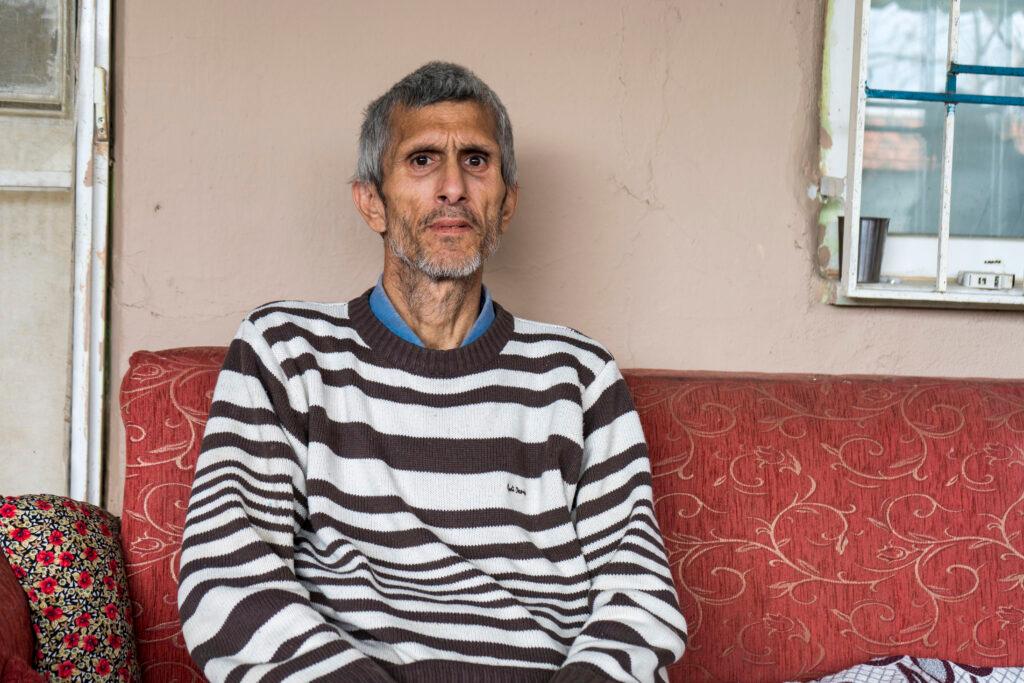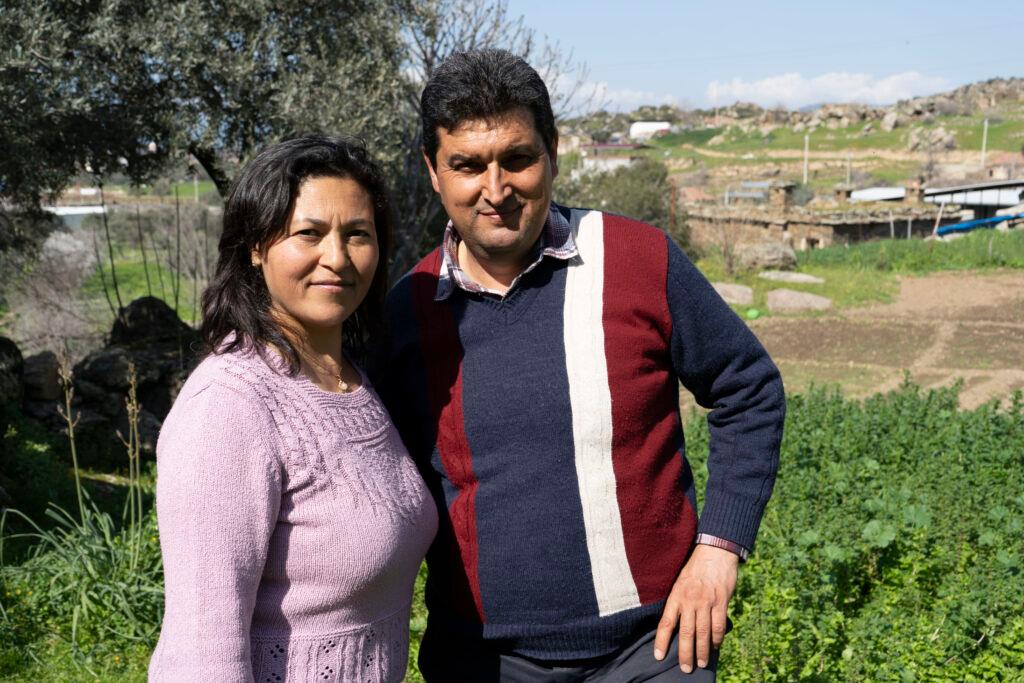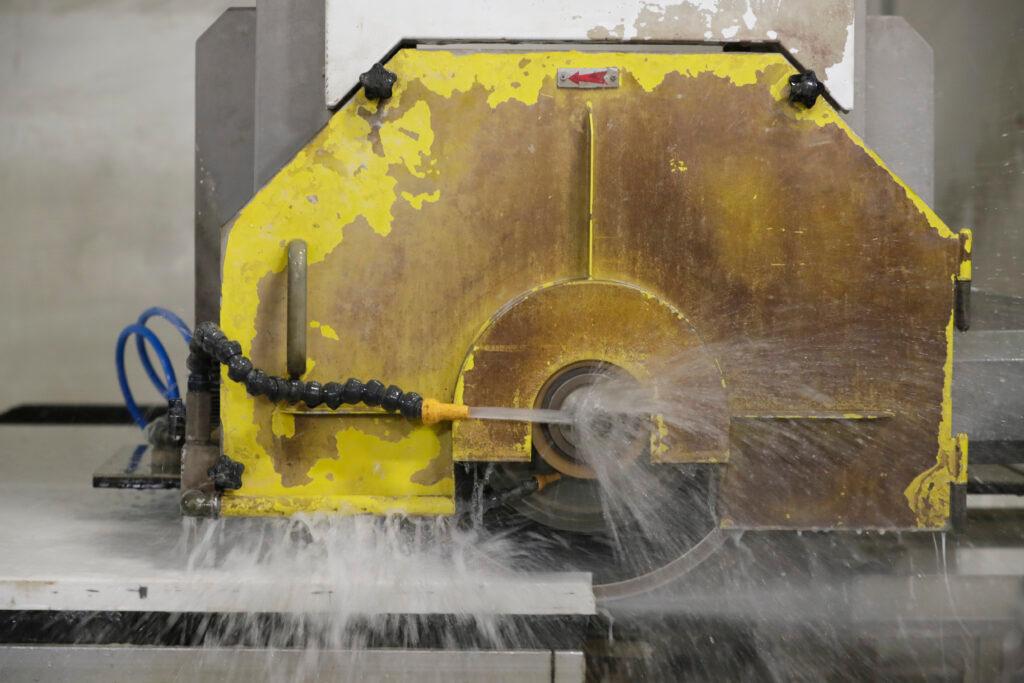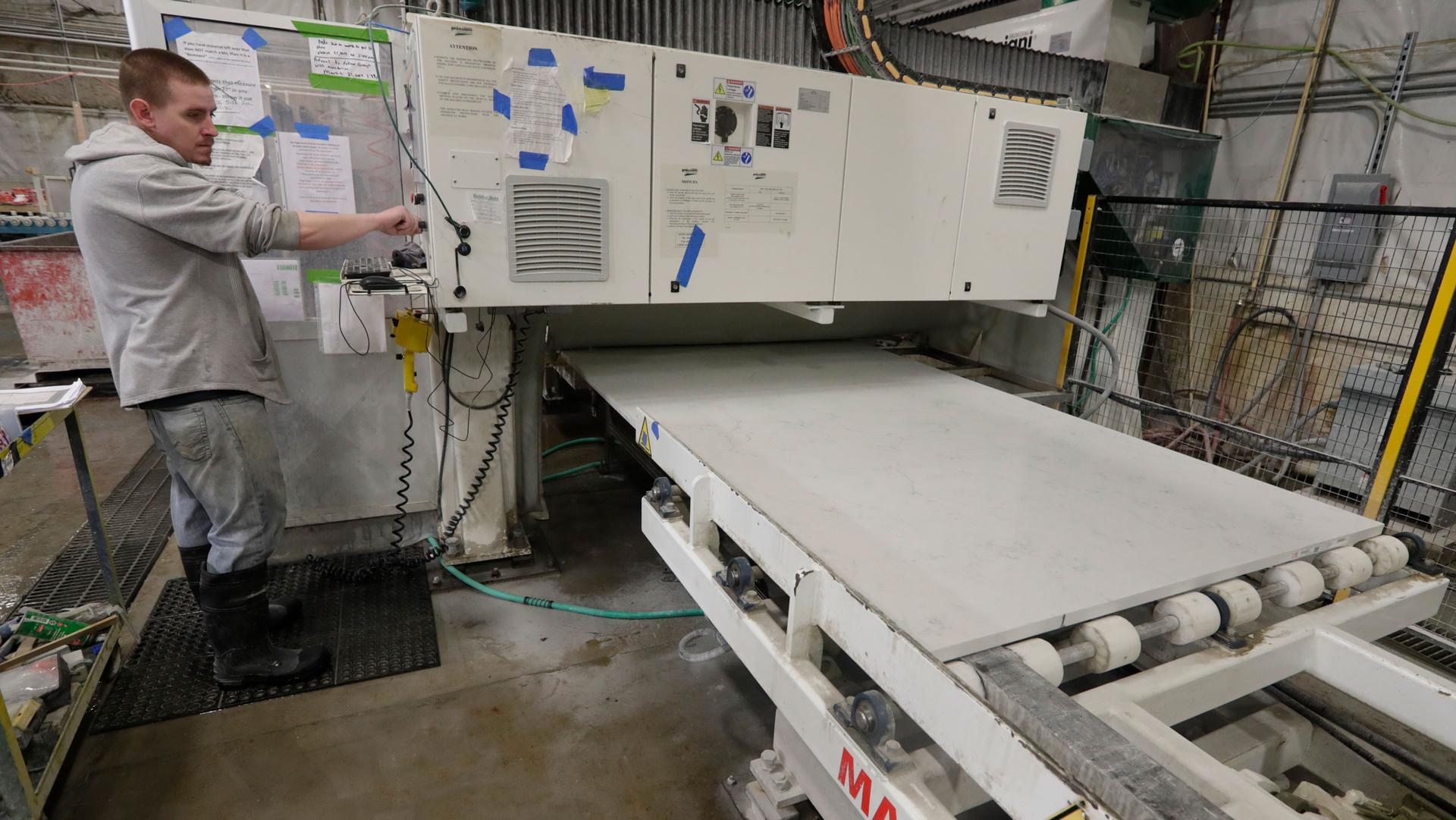In the Turkish town of Çine, it seems like just about everyone works in the quartz industry.
Every time there’s a controlled explosion to unearth the stone at the mine, dust carpets entire neighborhoods.
Şenol Girgin, who lives in Çine, spent years operating a machine that poured out manmade quartz so that it could get shaped into slabs.
“You could see the particles in the area where we were working. It was really dense with the particles. And they wouldn’t open the windows, we were working indoors the whole time and the whole area was closed. Just closed,” he said.
Each worker received a filtered face mask every six months. But one by one, Girgin’s coworkers still fell ill with silicosis—a lung disease caused by breathing in dust from silica-laden materials. The immune system typically produces mucus as a protective measure, but eventually, the mucus clogs the lungs, which inevitably leads to suffocation.
Growing up in Çine, Girgin saw a neighbor get sick and die within a year.
There is no cure for silicosis. When Girgin started to feel sick, he knew what was coming.
“I live in nature, and I can’t even smell the pine trees,” he said.
Girgin is now 47 years old and weighs just 100 pounds, a shocking change for anyone who has known him for more than a year or two. His tall, thin limbs and deep-set eyes give him the pained look of a prisoner of war. He can no longer work.

“They take mountains of men and turn them into nothing,” said his wife, Hülya Girgin.
“They take mountains of men and turn them into nothing.”
Hülya Girgin, wife of Şenol Girgin, who suffers from silicosis, Çine, Turkey
The Girgins traveled to another city to get a formal diagnosis to receive a disability pension from the government, but it barely covers the cost of food and medicine for their daughter, who has a disability of her own.
Turkish labor law requires factories to undergo regular health and safety inspections. But former employees in Çine said that their managerstamperedwith air-quality monitoring equipment to hide the dire conditions. Managers would get tipped off when inspectors were coming, workers say, and only then would they open the windows.
Several mines and the Turkish Ministry of Labor did not respond to repeated requests for comment.
Ahmet Uslu, a local environmental activist, runs an organization that helps over 100 workers suffering from silicosis.
According to Uslu, mining companies take regular scans of workers’ lungs but don’t share the results with the miners. Then, the companies fire the workers before they have a chance to get a formal diagnosis.
When Sayım Unal was diagnosed with silicosis in 2012, his company laid him off.
Today, he lives on a farm outside of Çine. Around his property are small, white stones — the same kind that he spent 16 years sorting in the mines.
Unal said that after a 10-hour shift, his manager would ask him to come back for another six hours to compensate for staff shortages and keep production going.
“The harder we worked, they wanted more,” he said. “They worked us like slaves. And after they realized we were no good for them anymore — they threw us away.”
“They worked us like slaves. And after they realized we were no good for them anymore — they threw us away.”
Sayım Unal, just outside of Çine, Turkey

Unal applied for worker’s compensation after being fired. He’s been in a legal fight with his company for the past 10 years. The company provided witnesses and photo evidence saying that Unal didn’t wear a protective mask.
Unal also said that many people avoid speaking publicly about silicosis because they want their children to get jobs in the mines.
For Unal, the solution is increased accountability from companies and the government.
“All we want is something that leads to practical legal steps from the government,” he said. “We want to see something that makes these companies responsible for the harm this job is causing.”
‘The most important thing is prevention’
In Spain, some companies working with quartz are taking steps to adopt stricter and safer rules to protect workers from dust.
Montemayor is the epicenter of Spain’s silicosis crisis, where over 300 people are sick in a town of roughly 3,000 residents.
At one small countertop company, workers use a high-tech cutter that sprays water onto a blade as it grinds through a slab of Silestone —a brand name for engineered quartz. This prevents the dust from going airborne and reaching workers’ lungs.
Industry experts say this is the best way to cut the material.

Juan Carlos Torres, the owner of the countertop business, said that for years, his employees cut the stone without water because they didn’t know any better. Cosentino, the maker of Silestone, used to sell the slabs without safety warnings.
Stone cutters across this region echo this story.
Juan Antonio Gonzales started his first job sanding engineered stone in Montemayor at just 16 years old. He didn’t work with the water spray and inhaled lots of dust as a result.
“My silicosis was so acute that just stepping out of the shower and reaching for a towel was too much. I’d have to put on my oxygen mask,” he said. “I could no longer pick up my baby daughter or even hold her in my arms.”
“My silicosis was so acute that just stepping out of the shower and reaching for a towel was too much. I’d have to put on my oxygen mask … I could no longer pick up my baby daughter, or even hold her in my arms.”
Juan Antonio Gonzales, Montemayor, Spain
Last fall, Gonzales got a double lung transplant. Though he’s on disability for life, and his body could still reject the transplants, he counts himself lucky compared to his friends.
Paco Zafra ran the first stone-cutting company in Montemayor. He said that silicosis blindsided him.
“I am so sorry for everyone who’s gotten sick,” he said. “I’m a human being, too. The disease is in my own family.”
Zafra said that the regional government still awards Cosentino for being a major employer in the area despite the silicosis crisis.
“And for what?” he said angrily. “For killing our young people. Cosentino should have had warning labels on its product, like Big Tobacco does on its cigarettes.”
Cosentino spokesperson Jose Luis Cuevas upholds that Cosentino never violated any laws, but does concede that the company could have done more to communicate safety information to its wholesale clients.
“I think each player in this business has to assume part of the responsibility,” he said. “Perhaps we could have been more proactive in the beginning, more present. But you can’t say that we weren’t informing.”
In 2017, the Criminal Court of Bilbao determined that Cosentino was jointly responsible for causing silicosis in several workers in smaller workshops because it did not inform them about any risk derived from handling their product.
And in 2023, Cosentino owner Francisco Martinez accepted a six-month suspended prison sentence for five counts of serious injury due to gross negligence.
Today, Silestone does come with safety labels, and the same information is available online. Cosentino is also trying to help healthy stone cutters cope with the crisis by financing group therapy sessions.
Cosentino and other firms have also started offering engineered stone countertops with less silica.
Industry experts predict that kitchen countertops will one day be silica-free. But in the short term, new cases of silicosis will likely continue to appear in Spain.
“What’s clear is that the damage is done,” Torres said. “We can’t give anyone their health back, so the most important thing is prevention. We need to use the right machinery.”
‘An ultimatum’
Some experts say the “right machinery” is not enough.
On July 1, Australia will ban engineered stone altogether — the first country in the world to do so.
The Work, Health and Safety agencies in Australia said that given the persistent lack of compliance with and enforcement of safety regulations in the engineered stone industry, banning the material was the way to keep workers safe.
The ban is the result of a yearslong campaign driven by workers, trade unions and health experts like Dr. Ryan Hoy, a specialist in work-related respiratory diseases at the Royal Melbourne Hospital.
“We thought silicosis had pretty much been eliminated in Australia,” Dr. Hoy said. “I didn’t see any patients at all with silicosis until 2016, 2017. But then all of a sudden we saw an explosion in patients with this condition.”
“I didn’t see any patients at all with silicosis until 2016, 2017. But then, all of a sudden, we saw an explosion in patients with this condition.”
Dr. Ryan Hoy, respiratory disease specialist, Royal Melbourne Hospital, Melbourne, Australia
Hoy said the medical community sounded the alarm about engineered stone relatively early. From 2016, he and his colleagues wrote to government agencies, warning them about the risk, but were met with no immediate action.
Instead, as more research came out about the health risks of engineered stone, unions took up the fight to ban its manufacture and importation.
Tradespeople like Kyle Goodwin started sharing their stories as part of a collective effort to ban engineered quartz.
The former stonemason from Queensland cut engineered stone countertops for 10 years. In 2018, at 33 years old, he was diagnosed with silicosis and given five to eight years to live.
“Instead of planning a family, we’re planning a funeral,” he said in an advertisement produced with CFMEU, Australia’s construction union.
This ad, part of the union’s 2022 “Stop This Killer Stone” campaign, aired across the country.
At around the same time, Australia had a change in government. In 2022, the Labor Party, which had strong union ties, returned to power.
The new labor government agreed to look into the feasibility of banning engineered stone. However, there was significant pushback from the industry.
Companies in Australia’s home-building sector warned a blanket ban would lead to job losses and construction delays.
Caesarstone, Australia’s largest producer of engineered stone, and other manufacturers lobbied for a partial ban that would still allow products with less than 40% silica to be sold. They argued that a total ban on engineered stone wouldn’t keep workers safe because other materials also emit silica dust when cut.
However, health experts say there’s no evidence that engineered stone with a lower silica content is any safer.
Caesarstone Australia declined a request to be interviewed for this story.
Meanwhile, unions grew frustrated. In October 2023, the Australian Council of Trade Unions(ACTU) voted to prohibit quartz on the nation’s buildings’ sites by July 2024 if the government had not acted by then.
Zach Smith, CFMEU’s national secretary, cited the unions’ threats of boycott as a turning point in the yearslong campaign against engineered stone. “It was pretty much unprecedented. You’d have to go back 30 years to the campaign to ban asbestos to find something similar,” Smith said. “But it was the only moral choice. Engineered stone is the asbestos of the 2020s.”
An ultimatum, he said, was the only way to go.
But the unions didn’t have to take matters into their own hands, after all.
On Dec. 13, 2023, the federal and state governments voted unanimously to ban the use, supply and manufacture of all engineered stone — regardless of silica content — starting July 1, 2024.
The ban will come too late for Kyle Goodwin.
He has already survived longer than doctors said he would. But the days are rough. Goodwin regularly battles fatigue, shortness of breath and a chronic cough. But he doesn’t like to dwell on it.
“With a disease like this, with no treatment and no cure, all you can do is stay positive in your head, and that’s what I try to do,” he said.
Goodwin plans to use the time he has left to advocate for a ban on engineered stone in as many countries as possible.
“The key message here is this is a preventable workplace illness,” he said. “Another generation shouldn’t have to die just because they’ve turned up to work.”
Editor’s note: Turkish translations from Sima Ghadirzadeh; fact-checking from
Dr. Albert Rizzo, American Lung Association; consultation from Turkish journalist Özer Akdemir
